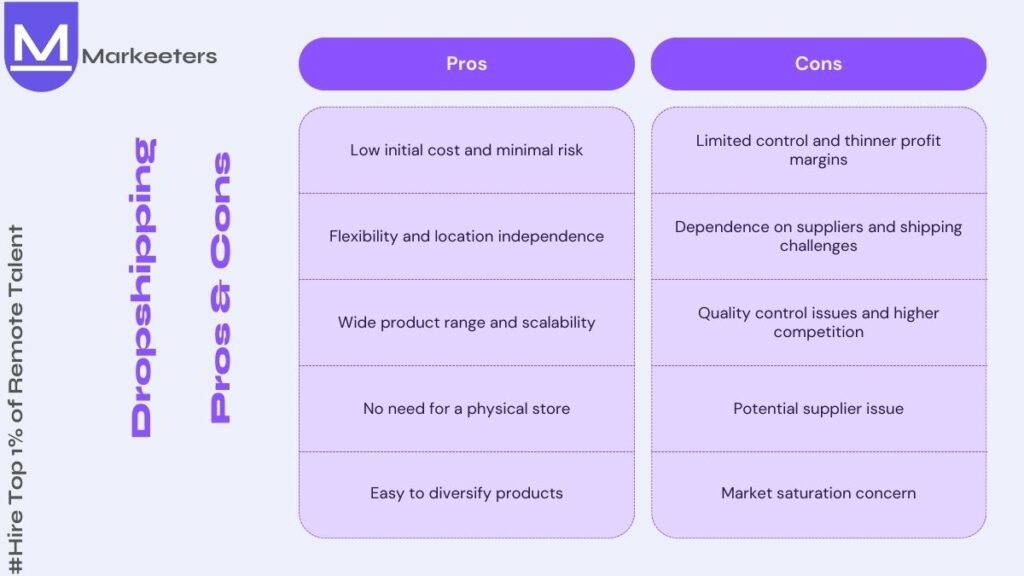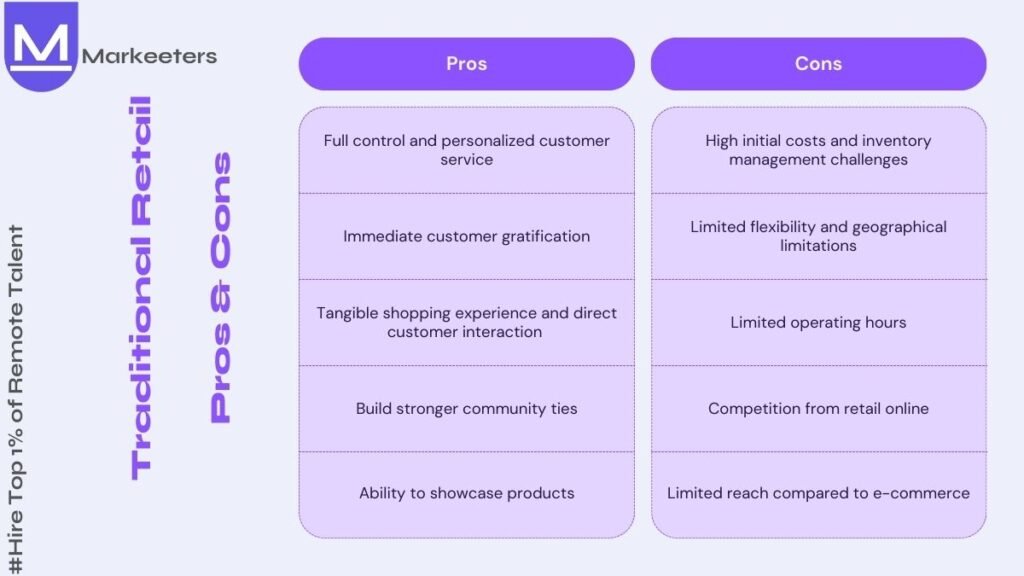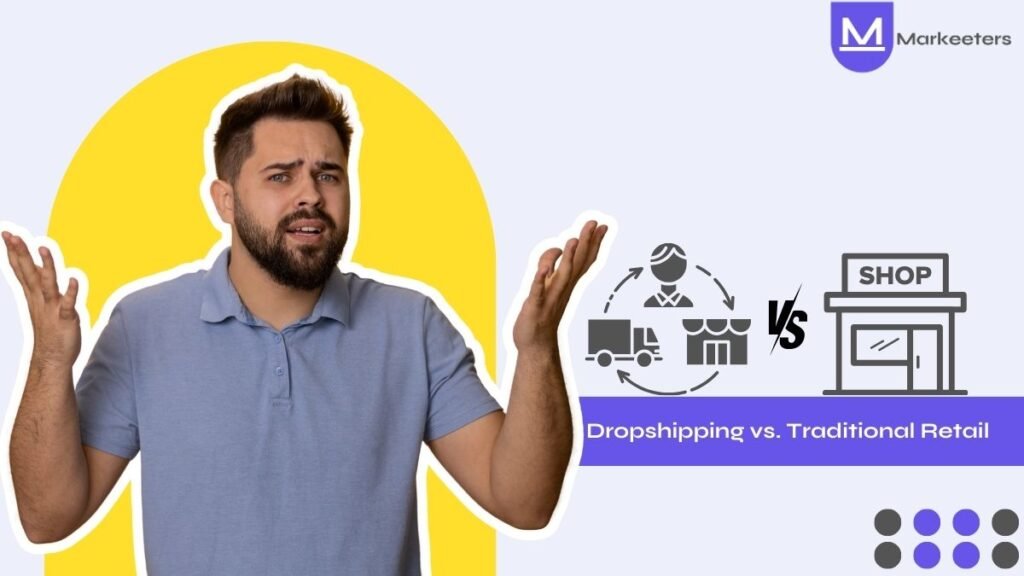Curious about Dropshipping vs. Traditional Retail? Our blog breaks it down for you. Make informed business choices today!
Introduction
The shopping experience has been constantly changing. In recent years, consumers have changed to online shopping. There are no long queues for the checkout, you can get products at discounted rates, and you don’t have to visit the store. You can simply order online, try it, and even return it if the product is not as per your standards.
However, there is a constant debate about Dropshipping vs. Traditional Retail. Each has its unique strengths and weaknesses. In this blog, we will delve into:
- What is Dropshipping? (Pros and Cons)
- What is Traditional Retail? (Pros and Cons)
- Dropshipping vs. Traditional Retail: A Quick Review
- Dropshipping vs. Traditional Retail: A Detailed Overview
Let’s dive in!
What is Dropshipping?
Dropshipping is an order completion strategy in which a business does not maintain an inventory of its products. The seller buys inventory from a third party, typically a manufacturer or wholesaler, as needed to fulfill orders. The most significant difference between dropshipping and the traditional retail model is that the selling merchant serves as an intermediary rather than stocking or maintaining products.
Around 27% of Online retailers have adopted dropshipping. The fashion dropshipping segment is predicted to grow at a CAGR of 24.9% between 2023 and 2030.
In simple terms,
- The buyer pays you for the product.
- When you receive the payment from the customer, only then you pay the supplier to fulfill the order.
- The final product is shipped straight from the supplier to the customer.
Example: Warmly
Pros and Cons

What is Traditional Retail?
Traditional retail is the method of selling products and services via physical stores, such as shops, boutiques, departmental stores, and specialty shops. In this situation, customers go to a physical store to see, try on, and analyze products before buying them. Remember when we were young and our families used to take us to the market? We used to visit various shops and try different clothes and footwear. In simple terms, that is traditional retailing.
Did you know that 70% customers are less likely to return to a store if they experience long waiting times on just one occasion? Your business can establish self-service kiosks to avoid long queues. According to NCR Corporation, retailers offering self-service options saw a 40% decrease in customer wait time.
Example: Macy’s
Pros and Cons

Learn more:
- Standard Vs Expedited Shipping in E-commerce
- SEO Freelancer vs. In-House SEO vs. SEO Agency: Which is Right for You?
Dropshipping vs. Traditional Retail: A Quick Review
| Aspect | Dropshipping | Traditional Retail |
|---|---|---|
| Inventory Management | No need to manage inventory; relies on suppliers | Requires stocking inventory; full control |
| Initial Costs | Low startup costs | High initial costs (inventory, storefront) |
| Flexibility | Location-independent operations | Physical presence limits flexibility |
| Shipping | Outsourced to suppliers, less control | In-house control; immediate fulfillment |
| Product Range | Wide range of products from multiple suppliers | Limited range, but more control over offerings |
| Scalability | Easily scalable with minimal risk | Limited scalability due to physical constraints |
| Brand Control | Limited control over branding and quality | Full control over branding and product quality |
| Customer Interaction | Limited or no face-to-face interaction | Personalized, face-to-face customer experience |
| Customer Reach | Global reach with potential for lower costs | Local or regional reach with higher costs |
| Competition | Higher competition due to lower barriers | Lower online competition; local competition |
| Operational Hours | 24×7 availability | Limited operating hours |
Learn more:
- Nearshoring vs Offshoring – Which is the Right Choice for Your Business?
- Why Hiring a Social Media Manager for a Small Business Matters?
Dropshipping vs. Traditional Retail: A Detailed Overview
Fundamentally, dropshipping is a simplified online business strategy that enables companies to market goods without ever maintaining inventories or handling shipping arrangements. The dropshipper collaborates with a supplier that sends the products straight to the buyers after completing the orders. In contrast, traditional retail includes companies buying products from suppliers, keeping them in a physical store, and selling them to the customers in-person or online.
Dropshipping vs. Traditional Retail: Inventory and Logistics
The areas of inventory management and logistics are where dropshipping and traditional retail differ most significantly:
- Dropshipping: Dropshippers can function with lower initial expenses, lower risk, and more variety in their product offerings since they do not need to store inventory. They cannot depend on their suppliers to fulfill orders and send them on time, which occasionally results in delayed deliveries and poor customer experiences.
- Traditional Retail: Traditional retailers have better control over product quality, order fulfillment, and shipping delays since they handle logistics and inventory in-house. This often leads to more reliable customer experiences. This strategy needs more significant infrastructure and resources, as well as more initial costs.
Dropshipping vs. Traditional Retail: Market Entry & Growth
The possibility of growth and market entry restrictions are crucial factors for business owners debating between dropshipping and traditional retail:
- Dropshipping: Dropshipping is an appealing choice for budding e-commerce businesses because it involves lower startup costs and minimum of infrastructure. It also provides easy access to the market. Dropshippers can quickly grow their business because they do not have to a invest huge amount in inventory management and transportation.
- Traditional Retail: Establishing a traditional retail company usually involves more startup cost, a secure physical location, employees, and inventory management. Therefore, it becomes difficult to enter the market and grow the business.
Dropshipping vs. Traditional Retail: Personalization and Product Choice
It is essential for the companies engaged in dropshipping and traditional retail to provide a wide selection of products and the customers’ needs constantly:
- Dropshipping: Dropshippers are free to try their hands at a wide range of products and niches. This enables companies to provide a more flexible and adaptable product selection by instantly adjusting to market developments and consumer preferences.
- Traditional Retailing: Traditional retailers can still adjust their product offers to meet changing customer preferences. However, it usually takes longer. It requires more resources. They also have to keep track of inventory management and logistics.
Dropshipping vs. Traditional Retail: Brand Identity and Customer Loyalty
Creating a strong brand image and maintaining customer relationships are essential for long-lasting success in dropshipping and traditional retail:
- Dropshipping: Dropshipping can make it harder to develop a consistent brand identity and maintain customer relationships. They do not have control over the quality, packing, and shipping of the products. Dropshippers can establish a strong brand image by emphasizing niche areas. They can use efficient marketing and customer service strategies. It will help develop customer loyalty.
- Traditional Retail: They have more control over how their brands are presented. Traditional retailers have more control over the quality of products and the entire customer experience. This helps build stronger brand identities. It increases customer loyalty as well.
Dropshipping vs Traditional Retail: Pricing and Profits
Pricing policies and profit margins are crucial factors for companies in both dropshipping and traditional retail:
- Dropshipping: Dropshipping enables businesses to give their consumers competitive prices since it reduces overhead and logistics costs. Dropshipping depends on suppliers for the product and its shipment. This results in extra fees or charges, so, the profit margins might be lower.
- Traditional Retail: Traditional retailers have to pay initial and overhead costs. This leads to higher prices for consumers. By taking advantage of bulk purchase savings and improving supply chain management, businesses might be able to increase profit margins by handling inventory and transportation internally.
Dropshipping vs. Traditional Retail: Future
Businesses need to adapt to technological changes with time. It is known that dropshipping and tradition retail have their advantages and disadvantages, even though it is hard to foresee the future with accuracy:
- Dropshipping: With the introduction of e-commerce, dropshipping has been gaining a lot of importance. Businesses and their owners can take advantage of the digital revolution. It involves fewer entry challenges and flexibility. But dropshippers need to concentrate on creating powerful brands. They need to focus on keeping customers happy. They need to constantly be updated with market trends to stay ahead of the crowd.
- Traditional Retail: Traditional retail has an important role in today’s business environment. With the invent of technology, traditional retail might survive by adopting technology. They should optimize their processes. They should focus on providing distinctive and interesting consumer experiences.
Dropshipping vs. Traditional Retail: Conclusion
There is no standard answer when it comes to dropshipping vs. traditional retail. It depends on personal preferences, resources, and market conditions. When you understand the differences, pros, and cons of every model, business owners and businesses can make a well-informed decision. Dropshipping businesses can be built with the help of Shopify, which will make it easy to take orders. You can speak with our Shopify expert to understand more.
Traditional retail is also popular, although it needs to adapt to a changing market environment. Businesses will succeed most when they are flexible, innovative, and customer-focused.
More resources:
- Top 5 Reasons to Hire a Social Media Manager
- What is a Digital Marketing Virtual Assistant & How To Hire?
FAQs
What is the difference between a dropshipper and a retailer?
A brick-and-mortar or online business would often need to commit large sums of money to buy products. When using the dropshipping business model, you can wait to buy a product until after the transaction has been completed and the buyer has paid you.
Is it better to dropship or wholesale?
You have more control over items and supplier interactions when you buy wholesale. Dropshipping transfers all authority to the dropshipper, including handling quality control and shipment. Better customer service through wholesale can lead to higher customer satisfaction.
Is Amazon a dropshipper?
Amazon involves storing, packing, and shipping your items. In contrast, dropshipping involves the management of inventory and order fulfillment by a third-party provider.





